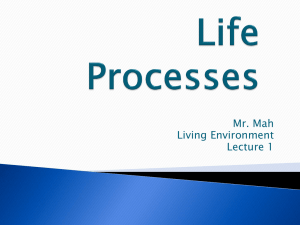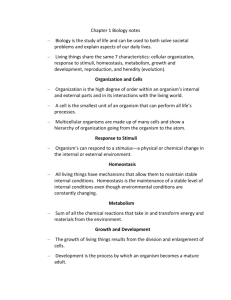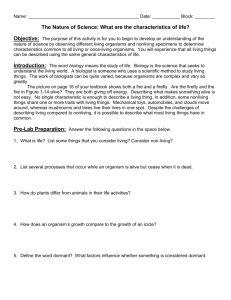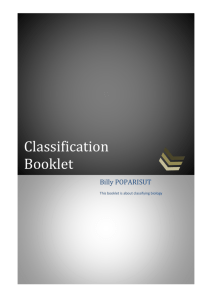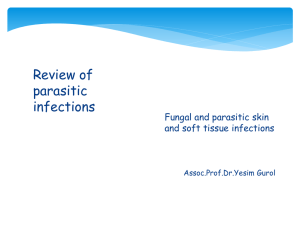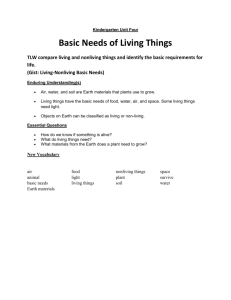Lab 2: Comparison of Living and Non
advertisement
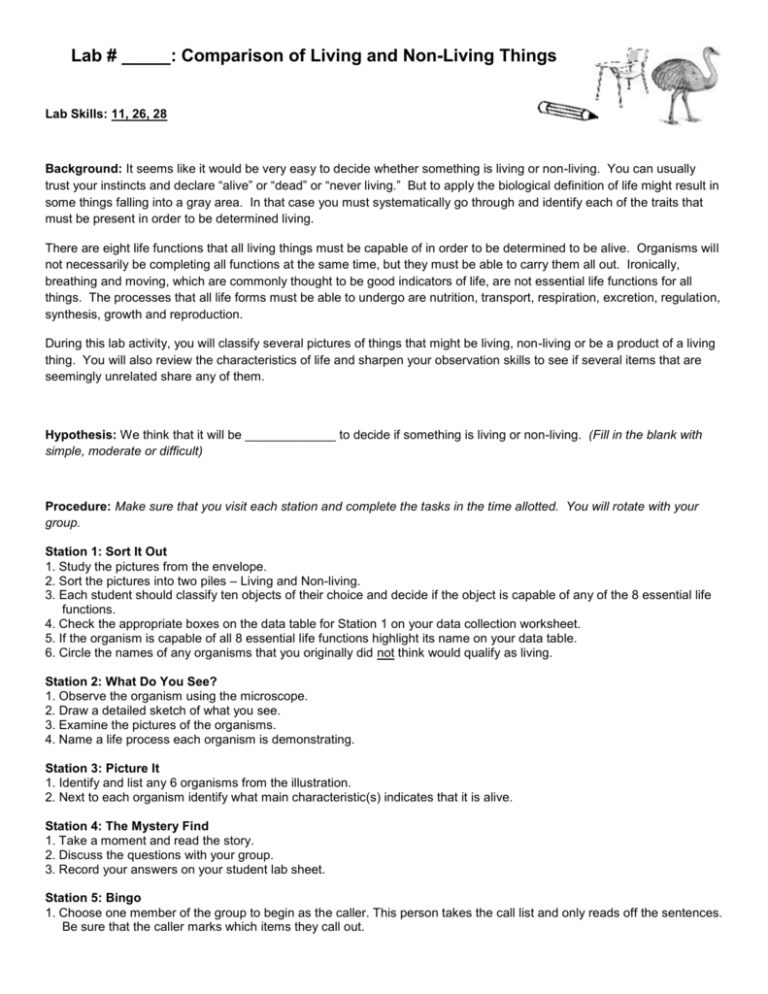
Lab # _____: Comparison of Living and Non-Living Things Lab Skills: 11, 26, 28 Background: It seems like it would be very easy to decide whether something is living or non-living. You can usually trust your instincts and declare “alive” or “dead” or “never living.” But to apply the biological definition of life might result in some things falling into a gray area. In that case you must systematically go through and identify each of the traits that must be present in order to be determined living. There are eight life functions that all living things must be capable of in order to be determined to be alive. Organisms will not necessarily be completing all functions at the same time, but they must be able to carry them all out. Ironically, breathing and moving, which are commonly thought to be good indicators of life, are not essential life functions for all things. The processes that all life forms must be able to undergo are nutrition, transport, respiration, excretion, regulation, synthesis, growth and reproduction. During this lab activity, you will classify several pictures of things that might be living, non-living or be a product of a living thing. You will also review the characteristics of life and sharpen your observation skills to see if several items that are seemingly unrelated share any of them. Hypothesis: We think that it will be _____________ to decide if something is living or non-living. (Fill in the blank with simple, moderate or difficult) Procedure: Make sure that you visit each station and complete the tasks in the time allotted. You will rotate with your group. Station 1: Sort It Out 1. Study the pictures from the envelope. 2. Sort the pictures into two piles – Living and Non-living. 3. Each student should classify ten objects of their choice and decide if the object is capable of any of the 8 essential life functions. 4. Check the appropriate boxes on the data table for Station 1 on your data collection worksheet. 5. If the organism is capable of all 8 essential life functions highlight its name on your data table. 6. Circle the names of any organisms that you originally did not think would qualify as living. Station 2: What Do You See? 1. Observe the organism using the microscope. 2. Draw a detailed sketch of what you see. 3. Examine the pictures of the organisms. 4. Name a life process each organism is demonstrating. Station 3: Picture It 1. Identify and list any 6 organisms from the illustration. 2. Next to each organism identify what main characteristic(s) indicates that it is alive. Station 4: The Mystery Find 1. Take a moment and read the story. 2. Discuss the questions with your group. 3. Record your answers on your student lab sheet. Station 5: Bingo 1. Choose one member of the group to begin as the caller. This person takes the call list and only reads off the sentences. Be sure that the caller marks which items they call out. 2. The other members of the group listen to the caller and play BINGO using the pennies/markers to cover their squares. When a player has covered 5 squares in a row either vertically, horizontally, or diagonally they are to call out BINGO. At that time they will read off their answers for the caller to check. 3. If time permits, rotate Bingo boards and caller. Station 6: Function Junction 1. Fold a blank sheet of paper into three equal sections. Label one section “Plants,” label one “Animals,” and the third section “Both.” 2. Remove the functions from the plastic bag and place them in appropriate column that you made. 3. Copy information into the appropriate column. Station 7: Cute but Confusing! 1. Look at the pictures of objects that are not living. You will notice that on them are drawings of human-like faces and expressions. 2. These same pictures were given to young children who were in first grade. When asked which objects were living and which ones were not living, many of the children said all of the objects were living! 3. Each lab group member should select a picture and write a short explanation for a first grader explaining why these pictures are not living even though they look like they are. Be descriptive, creative, and informative using language and terms that would keep a child’s attention. Use words they would understand. Include characteristics and functions of living organisms in your explanation. Analysis: (to be completed preferably on the back of your lab cover sheet) A. What processes do all living things have in common? B. Which life function is essential to the survival of a species but is not needed for an individual’s survival? C. Which feature of all living things does a virus lack that prevents it from being classified as an organism? D. Why can it sometimes be difficult to observe the processes common to living things? E. Which specimen did you find to be the most difficult to classify and why? F. Why aren’t moves and breathes included in the list of essential life functions? Comparing Living and Non-Living Things Data Collection Worksheet Growth Excretion Respiration Nutrition Regulation Reproductio n Synthesis Specimen Transport Station 1 Living or non-living? Station 2 Specimen 1 Sketch it in this box… Specimen 2 Sketch it in this box… Specimen 3 Which life function is being shown? Specimen 4 Which life function is being shown? Station 3 Specimen # 1 2 3 What is it? How do you know it is alive? 4 5 6 Station 4 A. B. C. Station 5 Who won game 1? Who won game 2 (if time permitted)? Who won game 3 (if time permitted)? Station 6 Staple your tri-fold answer sheet to your lab report. Station 7 Name: Name:

